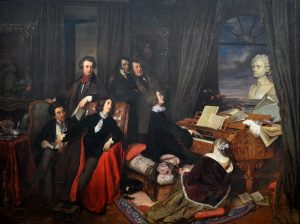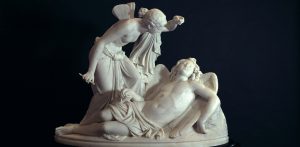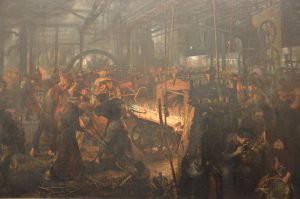AM: I have an appointment to pick up Sylvia Sleigh from the Intercontinental in my car and find the way blocked by the annual bicycle marathon that cuts through half the city. After impossible sidetracks I finally arrive in her suite, nearly an hour late, shaken. But part of it is sheer excitement over spending an afternoon in one of my favourite museums with one of my favourite painters. Sylvia Sleigh was born in 1916 and is therefore 87 years old, but rests only once during our four-hour stay in the Alte Nationalgalerie. Her eyes sparkle with delight whenever she discovers something that pleases her.
Josef Danhauser (1805–1845), Liszt am Flügel, 1840
Sylvia Sleigh: He must have been fun – Liszt! Cheerful, yes!
Antje Majewski: I think he was very theatrical…
SS: Oh yes, that’s what was fun! (Laughs.) I read a lot of stories about him and about George Sand, you know? They had a good time. That might be George Sand.
AM: Which one? This one? That’s true, it could be a lady.
SS: Well you know, she used to wear men’s clothes. As
Men all had long hair, you could do that.
AM: And she also smoked cigars, didn’t she?
SS: Yes, she did. Good writer, I read one of her books and I thought very highly of it.
AM: Yes, me too.
SS: Socially also very advanced.
AM: I think she was quite a glamorous or glamour loving woman and at the same time chose to write about –
SS: – she had a great deal of charisma, you know. I don’t think she was a beauty, though. I think she was fascinating.
Caspar David Friedrich (1774–1840), Mondnacht am Strand mit Fischern, um 1817
SS: My grandfather was a soldier. And I could already write, draw, paint, saw and everything with my left hand – he made me change. It was a very bad idea. Because it slowed me down in every way. It made it impossible for me to do sports. Because by the time I thought which hand to use I fell over.
AM: My husband is also left handed, but he can write with both hands. Which hand do you use now, for painting?
SS: My left. I use my right for minor work. I can use my right, I think. I can write rather slowly.
They had a nice show of Friedrich at the Met. He’s a fascinating painter. I only think he had one flaw. He did often paint the same scene again. I suppose his most popular.
AM: I think what he did was to do drawings and then used the drawings in his studio, so maybe he used the same drawing several times.
SS: He probably did. Well, I suppose if people like to repeat…
Reinhold Begas (1831–1911), Amor und Psyche, 1854-57
AM: What do you think about this one?
SS: I think it’s rather nice. I think: poor Psyche, she won’t get very far on those wings.
AM: They are a bit short.
SS: It’s sort of similar in a way to beauty and the beast. Because the sister of Beauty told her that she shouldn’t be with a monster. And a friend or relation of Psyche said probably Amor was a monster.
AM: But he looks very pretty.
SS: Yes, but she didn’t know. He only came to her at night.
AM: Oh, did he?
SS: Oh yeah. She did receive him for a long time, but he only came at night and she never saw him. And so then she went to look at him with an oil lamp and dropped some oil, so he woke up and flew away. And then Venus gave her all sorts of horrible tasks to perform before she could see him again.
AM: And she fell in love immediately when she saw him?
SS: Yes, and they were happy in the end. They lived happily ever after she had done all these nasty tasks.
AM: Have you ever felt tempted to paint Amor and Psyche?
SS: No.
AM: No? Why not?
SS: Oh, well, you see, the problem is getting two people who would take that part.
AM: But you did get two people for Venus and Mars[1], for example.
SS: Yes, that’s happened. It can happen. Well, actually Paul Rosano had a very attractive girlfriend, she wasn’t exactly beautiful but tremendously glamorous, there was something very very special about her, and I asked if they could sit for me, and she was rather impatient. And she said she would, but for a great deal of money, because she was used to doing commercial photography. And that’s very different, in commercial photography you have your photo taken quite quickly and it’s probably used a lot, so you get paid because it’s used a lot – but I can’t do that, so I said: ‘I’ can’t’. Well, and Paul said, he wanted more money, too. And I said: ‘I give you more money’, but it became less fun.
AM: And do you think for Amor and Psyche, would you have needed two people who were actually in love with each other?
SS: Well, if I could I would of course, that would be ideal. In this case it might have worked. Because they were. But it was a sad story. They lived together since they were in College. He had this band, you know, he was a singer, he sang beautifully, and they moved to New York and had an apartment and so on, and he tried to get work with music, which is almost impossible. You know what New York is; there is so much competition. And he had a best friend also as well as a girlfriend, who was in the band. And he was helping his best friend to put a loft together. In the meantime his best friend was having an affair with his lover.
Oh my god, this was so terrible. I have never seen anyone so… so… wounded. It was awful. It was painful even so see him. He didn’t speak to people a long time after that – well, not that long. And even then… I was so sorry. And then of course I think she wasn’t happy either…
AM: But he never went back.
SS: No, of course, if you’re hurt that much, you can’t.
AM: Hm.
SS: Love is strange and very tender for you. And I mean things like that can kill it right then. A relationship is …
AM: One always has to take great care with it, I think.
SS: Oh, I think so. Yes. Certainly, one should. If you have a good relationship, it’s an extreme folly to do anything that spoils it. Because it’s so rare. I don’t know, there aren’t many people you can feel close to in your life. And if you find one, you shouldn’t take any risk. It’s actually a wonderful thing when it happens. It’s the best thing in the world. The nearest thing to paradise. (Both laugh).
Well… what have we now?
AM: I think there’s some Courbet round the corner.
SS: Let’s see.
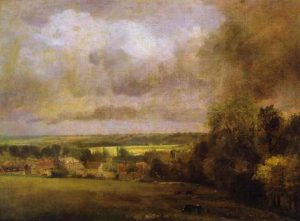
John Constable (1776-1837), Higham Village on the River Stour, um 1804
AM: When we were looking at the Constable I thought, the countryside in England looks so familiar even to me, it looks as if it was my childhood country side, I don’t know why –
SS: Well, it’s Europe!
AM: Yes, but it is different from Germany. Somehow the fields are smaller…
SS: The German fields are much bigger, aren’t they? It’s true.
AM: – and maybe that gives me the feeling it’s made for children. It’s a different size.
SS: Oh yeah? How do you mean, made for children?
AM: The size of everything, the trees are not so tall, and the fields are not so big…
SS: That’s true; it’s a sort of a gentle landscape.
AM: And clouds are always like clouds in a children’s book.
SS: Oh yeah? Well, you see, it’s so damp that everything does very well; flowers, roses and things do very well in a mild, damp climate. It’s more difficult to grow things in New York. I mean, it has a climate more like Seattle, very damp, mild.
In a way I’ve always felt rather rejected in England. I’d rather be somewhere where they think better of me.[2] Especially as the people I thought were friends are no longer… anyway I’ve had some quite nice reviews, you know? But, I mean, nothing happened, I didn’t get a gallery and nobody bought anything after my show, so after that, I didn’t feel it was a great success. (Laughs.)
AM: The landscape in your Invitation to a Voyage[3] is American: lots of space that stretches out. But the Woodside looks very intimate, very much at ease. In the beginning, were there as many people? I mean, was it a big party that went down the Hudson?
SS: Oh, yes, let me just think how many couples there were. I have forgotten, I have a photograph of them all. I now think there were about five couples, but not all of them were there the first time.
Laurence and I staid the night with Betty Parsons, not with her, she wasn’t there, but in her apartment, went out to dinner with Barnett Newman and his wife Annalee, and it was my first air-conditioned restaurant, we were frozen to death. Outside I think it was 108, and inside it was about 54 (it probably wasn’t, it felt like that). Anyway, then afterwards we went to Birdland and heard Ornette Coleman, it was very exiting. We had had his record before, but we never heard him in person. Barnett knew him, so we were introduced! It was very exiting. Years later, I met him again.
Anyway, so then the next day we took the train up the Hudson, quite a long way, and Barnett Newman said, there might be seats on the left side, then we get a room with a view. And when we got to Garrison, and he saw this castle, which reminded me of a Claude – you know, he did a painting called The Enchanted Castle? It was actually in England for a long time.
AM: By whom? By which painter?
SS: Claude Le Lorraine. And this looked to me like that. I said: ‘I absolutely have to paint this!’ And I took twenty years before I could. And I could because I was teaching at the New School and one of my students was Warren Perkins and he was a very engaged person, very nice. I told him about this. ‘Oh’, he said, ‘we can manage that. I have this van, I’ll take you! And any time – you can help me with my painting.’ I said: ‘That would be absolutely fine!’ So we used to go down there and he was rather a good cook. We used to have extraordinary lunches, because we always rivalled with one another to see who could make the most delicious lunch. So we had a jolly good time.
The only thing was that we had to go down there rather early because otherwise the castle became a silhouette. So we had paint to hard first and then have our lunch. Finally what happened was, I fell so much in love with it and I wanted to do this big painting, you see. I didn’t really think how big I was going to do it. It got bigger! (Laughs.)
Anyhow, what happened was, we went down in his van, and I made a very nice lunch, chicken breasts in sauce and champagne, cheap champagne (Laughs), bread and cheese and grapes, you know, all that, and it was very very nice and we had great fun. I wouldn’t have anybody eat before I had photographed them because of the light. (Laughs.) We had great fun. And we took lots of pictures. Then, luckily, John Perrault came. Well, he took loads of more pictures when we were having a picnic. I didn’t. So I used his photos for the Woodside. Because I hadn’t thought I’d do that. But he gave them to me, and I thought: ‘I’d better do the other side’, and I did. So that was the story of that.
I used to photograph but I always sort of got people to come to the house and pose, so I could paint a portrait of them. With photos you don’t have enough information mostly to do a good portrait of someone, the colours are always difficult. But I couldn’t possibly work on that great painting outdoors, no way! For a great deal of what I had to do, I had to stand on steps. And than there were all these leaves and all these stones. Actually, some friends of mine, for my first showing of it, were very sweet; they came in and helped me. A young playwright who needed a job did some stones, too. He was the best person, really, because he did what I told him. As he wasn’t a painter, you see. Few painters like to do what you tell them, they do what they do. (Laughs.) So I had to redo some of this. But at least it covered the ground.
AM: Were you happy with the result?
SS: Yes, it was fine!
AM: Because I can still not imagine… of course it would save some time if I could use an assistant, but I can’t really see someone else working in my painting, I’m sure I would have to paint over it.
SS: I would have liked to have done it all myself, but even – it’s not bad, I looked at it now and I can’t remember which one I did so it must be all right. (Both laugh.)
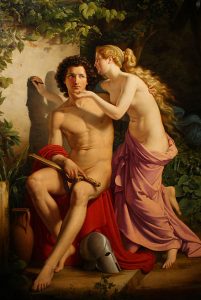 Eduard Daege (1805-1883), Die Erfindung der Malerei, 1832
Eduard Daege (1805-1883), Die Erfindung der Malerei, 1832
AM: I think this man looks like Paul Rosano, especially his mouth. But the way he looks in the interview, in the film about you[4], not in your paintings.
SS: When we were doing the film, he brought his wife and sons and they were so beautiful, the three of them, the wife and the two sons, I wished so much I could paint them. But of course they lived too far.
AM: It doesn’t happen to me a lot of times that I see someone, and think: I really want to paint this person.
SS: I often – well, not often – every now and then I think I would like to paint someone; then when I get to know them a little bit, I don’t think I do. (Laughs.) I do think he looked great, but… because, actually if a person isn’t sympathetic to what you’re doing, I think it’s much harder to paint them. Of course a lot of especially male painters, they don’t care. They look upon a person as an object and they can do what they like, but I don’t. I like to have a rapport with the person. And so that I feel I understand them somewhat and they are sympathetic to what I’m doing. Otherwise it’s not very pleasant.
AM: And what about the female artists that you portrayed? You did a lot of portraits of your female artist friends, didn’t you?
SS: That’s always easy.
AM: That’s easy.
SS: Yeah. There’s no problem there. Because I know them well usually. Not always. After all, I am a feminist, so I get on fairly well. Of course some of them aren’t and then I don’t.
I have an older friend who I’m very fond of, but we disagree about a great many things. She doesn’t believe that women have a bad position. She thinks it’s lovely! I didn’t understand that at all. But I think she refuses to see what really happens. She loved her husband very much and, you know, I think he was quite unaware of anything like that and so she goes on with his idea.
AM: And was she an artist as well?
SS: Well, she gave it up for him, of course. I don’t know that she would have been a very great artist or anything like that, but she used to paint. I nearly did give it up for my first husband, too.
AM: You did, really?
SS: Almost, not quite. He did his best.
AM: And did he want you to?
SS: Well, he wouldn’t have said so. But I think he did all he could to prevent me. He made jobs for me, you know, that sort of thing. I made all my own clothes and painted the house and all that sort of thing. Upholster the furniture. So, you know, I had very little time to work. And you see the point was that I think he was so envious because until lately I never had any trouble painting, I just never had blocks or things like that which he did. So there was I, painting away, happy as a sandboy, and he wasn’t. (Laughs.)
AM: And he was a painter as well?
SS: Yes. But I think he was a drawer, a draftsman, because I don’t think he had a feeling for paint. I mean his pictures all looked as if they were made out of linoleum. I think. But his drawings were lovely, and he was much more skilful than I am. I never was a very good draftsperson.
AM: I wouldn’t say so.
SS: My whole trouble is, you see, when I was in art school, they made up their mind that I was no good at anything and they told me they couldn’t think why I was taking it up if I had no talent. That went down very badly with me and I lost a lot of self-esteem. I really hated drawing because that was what I mostly did with them, you see. I taught myself drawing in the Dramatic Society, that was fun. When I left school I gave it up. Well, I said to myself, I have no talent at all; it’s stupid to go on with it. But then I was so miserable, you see, I needed to go on with that, no matter if I had talent or not.
AM: What a good decision.
SS: Yes, it was. But you know, you only stand so much negation.
AM: I think it could even be better to have not so much talent in the beginning, to have to work harder.
SS: That’s true, that’s what my husband said, he said ‘You’re lucky, you didn’t really have to unlearn what they taught you at school’. Because most artists who are teachers try to make you work like them. I taught quite a bit and I was very careful to keep my mind open, because it’s a shame to spoil their creation. So that was another thing that made the marriage not very good. Especially not very good for me. We had known each other for a long time. I knew him when he was seventeen and I was nineteen, you see. I told him at the time: ‘You’re too young for me’, and he said: ‘No, no, I’m very wise.’
AM: So you have been married for more then ten years, then, in your first marriage.
SS: Twelve years. I mean, the last six years really, we were married, but we weren’t involved with one another. He went to work to Cambridge and I was in the country.
AM: And you already knew Laurence.
SS: Yes, yes. We were very much in love. (Laughs.) I think that annoyed him very much. At first he didn’t sort of care, because he didn’t really want me very much, but then of course, you know how people are, they want what they can’t have. And as I said to you, how can you love someone if they really wound you badly. You can’t really go back to them at all. You can, but not quite in the same way. – Which is sad. Well, not in that case it was sad. I think, the sooner I got rid of him the better. But I mean, Laurence was tremendously supportive, although he never wrote much about me, about my work.[5] But he always would sit for me and all that sort of thing. Even if he was sometimes jealous a bit I think! He said: ‘You’re so lucky, you can hang your work up on a wall’ and I said: ‘Yes, but very few people see it, whereas if you write for a magazine hundreds of peoples see it.‘
AM: That’s true. But then a lot of people might read it just like that and forget about it.
SS: But on the other hand, he was very pleased – we were in Pittsburgh, soon after we came to America, and he was on a Jury, to choose a show there, and a nice man came up to me and said: ‘Do tell your husband that I so much look forward to all his articles and you know, I’ve read them all’ and so on, and Laurence was certainly pleased, because he said: ‘When you send the work out like that, it sort of goes into the blue and you don’t know what happens, or what people think.’ It encouraged him. But I always think if two people are artists of any kind there is a sort of rivalry, a little bit.
AM: Hmm.
SS: No? One gets on more than the other.
AM: I just think sometimes that maybe Ingo is the better artist and then I get jealous, a little bit.
SS: Well, there you are. But I mean, that’s natural. It doesn’t mean anything bad.
AM: I just think he can understand everything about my paintings, I maybe cannot understand his books fully. There remain parts of what he is doing that I don’t understand, I don’t understand how it is possible for him to arrive there.
SS: Don’t you ask him?
AM: He doesn’t answer!
SS: Oh! (Both laugh.) Oh dear! Perhaps he doesn’t know?
AM: He doesn’t like to talk about his work while he is working so I never get to see his books while he is still writing them.
SS: Oh, I see. People are like that. But Laurence, that was nice, it was the way asked me about things… I enjoyed his ideas very much. That was fun. But we had a pretty good relationship as far as our work went; only occasionally there was a bit of jealousy. And of course I don’t think I thought jealous of him because he was a writer and I liked his work very much. He was wonderful to exchange ideas with. Sometimes I even could, you know, make a suggestion that was useful occasionally. But of course, I wasn’t so well read as he was and if you have a household to look after you don’t have that much time for reading, so in a way, that was not good, then. I should have been able to read more and be more up to date with him. Well, nothing is perfect, so… But on the whole I think it was very nice.
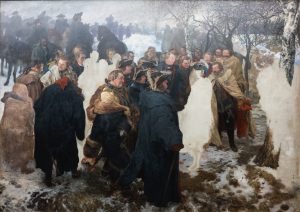 Adolph Menzel (1815-1905), Ansprache Friedrichs des Großen an seine Generale vor der Schlacht bei Leuthen 1757, 1859-61
Adolph Menzel (1815-1905), Ansprache Friedrichs des Großen an seine Generale vor der Schlacht bei Leuthen 1757, 1859-61
SS: What’s going on?
AM: This is a painting by Menzel, the one I talked about before, the small painter, and it’s a scene from the wars of Friedrich the Great of Prussia, and evidently he hasn’t finished it –
SS: Yeah, I see! These ghosts… He was an interesting person; not very nice!
Adolph Menzel (1815-1905), Das Eisenwalzwerk (Moderne Zyklopen), 1872-1875
AM: This is his painting of workers in a factory.
SS: Yes, I see. What kind of factory is it? Is it steel?
AM: I think it is a steel factory. Oh, it’s an ‘iron-rolling mill’. Have a look.
SS: Aha. I don’t think I’ve ever done any workers.
AM: I have. I’ve done a very classic worker in a blue overall.
SS: Are you cold?
AM: Yes, I think it’s cold in here. I should have taken a jacket.
SS: How curious! I’m not! But than I’ve got a woolly on.
GONG
SS: Oh! I suppose we should leave.
AM: Time passed by very quickly! God, we’ve been in here for a long time!
Loudspeaker: Sehr geehrte Besucher! Das Museum schließt in wenigen Minuten! The museum will close in a few minutes!
SS: Oh, we shall miss the postcards!
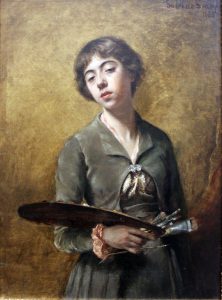
Sabine Lepsius (1864-1942), Selbstbildnis, 1885
AM: There’s one last painting that I would like to show you. She’s a German painter that is not very well known from the last century, and I always liked it very much. – Finally one woman in the whole museum.
SS: Is that all?
AM: I think so.
SS: Didn’t we see one other one?
AM: Maybe upstairs, somewhere.
SS: Oh, no perhaps it was the portrait of one. Well, but that’s nothing new, is it.
AM: No, it isn’t.
SS: I think it is much better, I must say, the Met has about six eighteen century ones. I mean, not six different women.
AM: But the Met is such a big museum.
SS: I think there are only actually three women, and like six paintings. I think they’re all French, too. Vigée Lebrun.
AM: Oh yes.
SS: And then there is some Angelica Kauffmann. Well, she’s German.
We were asked to give at a women’s school a talk on neglected artists, and I gave a talk on Angelica Kauffmann. And someone said: But she wasn’t neglected, what are you talking about? – and I said: No, she wasn’t, but she’s now. Well, you know, people think she’s sweet and weak – not true!
AM: No, Angelika Kauffmann was a very strong person, she moved a lot…
SS: -yeah, I think so. She did a very nice portrait of Goethe, they were close friends at one point, but he didn’t like it. I think it was just being antifeminist.
AM: No, he was very proud of his looks.
SS: But she made him a very nice portrait. I think he didn’t think it was masculine looking enough.
In:
Neue Review, Nr.2, July 2003, p. 30 – 35
[1] Sylvia Sleigh, Venus and Mars: Maureen Connor and Paul Rosano (1974) Maureen Connor was an artist friend; Paul Rosano was Sleighs model for many paintings. Like the Pre-Raffaelites she is so affected to, she used mainly two different models for her portraits of naked or semi-naked male youths: Paul Rosano and Philip Golub, son of the painter Leon Golub.
[2] Sleigh was born in England and moved with her second husband, the critic Laurence Alloway, to New York in 1961, returning to London to have her second solo show, Statues in the Crystal Palace Garden in 1962.
[3] Sylvia Sleigh, Invitation to a Voyage: The Hudson River at Fishkill (1979-99), is her most ambitious painting. It is an installation, consisting of two parts: Waterside and Woodside.
[4] „Look Here!’ A portrait of Sylvia Sleigh. A Documentary Work-in-Progress is a documentary film by Paula Ewin and Diana Sutherlin (Oweeno Productions), started in 1998 and still to be finished.
[5] Laurence Alloway was a very important critic of Pop Art, a term he coined. He had been Deputy Director of the ICA in London and became Curator of the Solomon R. Guggenheim Museum in New York 1962 – 66.
